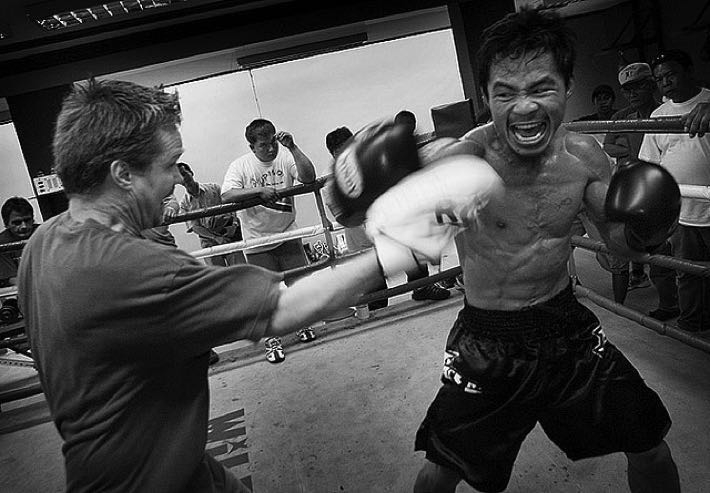 There’s no doubt that boxing is a global sport and it’s this factor that brings so much coverage in the betting world. It doesn’t pull in the punters on a regular scale compared with the likes of football or horse racing, but the times when fights are available the boxing markets tend to be pretty well covered.
There’s no doubt that boxing is a global sport and it’s this factor that brings so much coverage in the betting world. It doesn’t pull in the punters on a regular scale compared with the likes of football or horse racing, but the times when fights are available the boxing markets tend to be pretty well covered.
The bigger fights come in the form of world title fights. The likes of Klitschko, Mayweather, Pacquiao or Khan fights are the current highlights of the boxing calendar. Competitions such as Prize fighter have also brought a new dimension to the boxing betting markets in the form of a one night tournament knock out.
Boxing is one of those sports that goes through popular and less popular periods in time, depending on the popularity of names fighting in any given era. For example, throughout the days of Ali, Foreman and Frazier, it was argued that these were the ‘golden days’ of the modern era for the sport. Through the 90’s the likes of Tyson, Lewis and Holyfield were seen as the new breed and then again throughout the mid-late 2000’s, the Klitschko brothers brought a fresh appeal to the sport.
In terms of betting, it tends to follow a very similar trend and this reflects in the amount of exposure that a lot of bookmakers give the sport. What will never be lost from boxing the sheer volume of fights taking place around the world. Whilst the magnitude and quality to a certain extent, of these fights will vary each week, the volume that are taking place these days make it a no-brainer for bookmakers to offer markets on them.
It’s fair to say that boxing is a sport that bookmakers love to target, however it’s a also a sport where certain fighters can be huge favourites over their opponents, which results in none attractive betting opportunities for punters. It’s for this reason why many bookmakers have made a huge number of markets available to bet on, of which we will discuss at greater depth later in this article.
- In this Article:
- Bookmakers
- How to Bet
- Betting Markets
- Betting Rules
- About Boxing
Best Boxing Betting Sites
#1 – Ladbrokes
For most boxing fans, Ladbrokes will offer you all you could really need from your bookmaker. The only difference is that they don’t quite have the market coverage that a Sky Bet has and they don’t quite have as competitive pricing.
The range of fights that Ladbrokes cover is extensive to say the least. In fact, sticking with the same Amir Kahn fight that we mentioned in the Sky Bet section, Ladbrokes are actually offering up 25 markets to bet on, which is 5 more than Sky Bet.
I guess from what we have conceived, you may struggle to see why Ladbrokes is ranked at number 3, when it appears they can at worst match Sky Bet for markets and number of fights. Well, there is one major downside to the sportsbook and that’s their pricing. At no point in our testing did we find that were anywhere near the best priced bookmakers.
How to Bet on Boxing

As you will have likely gathered by now, being able to be ton boxing is now a very simple procedure. All the major bookmakers these days offer up a decent range of fights and markets on a weekly basis.
The difference comes when you compare it to a sport such as football. Fight generally only take place at the weekend and any midweek bouts usually aren’t much to write home about. Even with all that taken into account, and as we have already highlighted, some bookmakers are better than others, so it’s worth checking out our top 3 to see which suits you best.
Betting Markets
The betting markets on offer for boxing matches are definitely fewer than a lot other sports. For example, a football match will easily have well in excess of 100 markets to bet on, whilst boxing you are lucky to get over 20. Let’s run you through some of the major ones.
Fight Result
As with pretty much a any sport, the most bet on market will be the fight result. This will allow you to pick one of three results, including either of the two boxers and also the tie. Expanding from that you will be able to select which round a certain fighter will win the fight. This can be done in the form of group betting (selecting multiple rounds) or simply selecting a singular round. These markets are sometimes combined with the method of victory as well. So, you may look to bet on Boxer A to win in the 8th round via TKO, for example.
Distance Markets
Other categories for boxing markets may include distance markets (when will the fight be won, when will the fight be won in groups of rounds), Round betting (either selecting a single round to win or groups from 2, 3 or even 4 rounds per group), total rounds (the total number of rounds the fight will last for before a winner has been decided) and also specials (these might include the final judgment, split decision markets, majority decision markets, knockout within 60 seconds or to get knocked down then win the fight).
Boxing Bets
- To Win – Basically this market allows you to pick the overall winner of the fight. This can be either by points, Technical Knockout (TKO), Knockout (KO) or disqualification.
- Total Rounds – You can select how many rounds the fight will last for. This is generally an over or under line set by the bookmaker and you can select either.
- Round Betting – This market allows you to select a fighter and the round they will win in. You can also choose if the fighter wins by decision or technical decision (points) after all the rounds are complete.
- Round Group Betting – Similar to round betting, but instead you choose a cluster of rounds in your selection. So it might be rounds 1-3, 4-6, 7-9 or 10-12 in a 12 round fight.
- Fight Outcome – Selecting the outcome of the fight is possible and will include KO, TKO, disqualification, technical decision or draw. You will need to select the correct winner of the fight in this market as well.
- Accumulator Betting – Tournaments such as prize fighter allow you to pick winner from all the first round matches. As boxers progress into the next rounds accumulator bets can be amended for future rounds.
Boxing Betting Rules

As with the sport itself, there are a number of general betting riles to be aware with boxing. The main one is that bets will be settled as the official result upon completion of the fight. Any amendments to this after the fight has completed will not affect already settled bets. This works in the same way that if the wrong result is read out, the correct result will be paid out on.
In the event that a bet has been placed and a boxer has withdrawn from the fight then all bets will become void, unless a rematch takes place within 30 days of the originally proposed date. This will also occur if the scheduled number of rounds for a fight differs from that of what was originally priced up.
We have compiled some of the industry standard boxing betting rules for you. If you are unsure of a circumstance that could or has arisen then we encourage you to contact your bookmaker for further information.
Rule Highlights
- Boxer Withdraws – If a boxer withdraws from a fight prior to that fight started then bets will be carried over providing that fight takes place within 30 days. If the boxer is replaced by another fighter then the bet will become void.
- First Round Bell – Once the bell for the first round has started all bets will become accountable for.
- Draw – In the event the fight is deemed as a draw all bets will be returned on any unsettled outcomes. This is usually just applies to the win only market.
Weight Classifications

It obviously wouldn’t be fair to pit a boxer who weighs almost twice as much as another fighter in the ring with the smaller person, so boxing uses weight classification in order to separate the boxers into different groups. The lower limit of a weight class is the same as the upper limit to the class below it, which means that boxers can sometimes move between the classifications. Heavyweight is the top class in professional boxing, which has no upper weight limit, whilst it’s known as super heavyweight in amateur boxing.
Here is a look at the various weight classes in professional boxing. Annoyingly, the different boxing organisations call the various weight classifications by different names, so we’ll list the alternatives afterwards. For this table, we’re just going to give you the titles chosen by the World Boxing Council:
| Classification | Year Founded | Lower Weight Limit | Upper Weight Limit |
|---|---|---|---|
| Atomweight | 2007 | 7 stone, 4 pounds | 7 stone, 7 pounds |
| Strawweight | 1987 | 7 stone, 7 pounds | 7 stone, 10 pounds |
| Light Flyweight | 1975 | 7 stone, 10 pounds | 8 stone |
| Flyweight | 1911 | 8 stone | 8 stone, 3 pounds |
| Super Flyweight | 1980 | 8 stone, 3 pounds | 8 stone, 6 pounds |
| Bantamweight | 1894 | 8 stone, 6 pounds | 8 stone, 10 pounds |
| Super Bantamweight | 1976 | 8 stone, 10 pounds | 9 stone |
| Featherweight | 1889 | 9 stone | 9 stone, 4 pounds |
| Super Featherweight | 1959 | 9 stone, 4 pounds | 9 stone, 9 pounds |
| Lightweight | 1886 | 9 stone, 9 pounds | 10 stone |
| Super Lightweight | 1959 | 10 stone | 10 stone, 7 pounds |
| Welterweight | 1914 | 10 stone, 7 pounds | 11 stone |
| Super Welterweight | 1962 | 11 stone | 11 stone, 6 pounds |
| Middleweight | 1884 | 11 stone, 6 pounds | 12 stone |
| Super Middleweight | 1984 | 12 stone | 12 stone, 7 pounds |
| Light Heavyweight | 1913 | 12 stone, 7 pounds | 14 stone, 4 pounds |
| Cruiserweight | 1980 | 14 stone, 4 pounds | 16 stone |
| Heavyweight | 1884 | 16 stone | No Upper Limit |
The WBC introduce a new weight, Bridgerweight, in 2020, which confuses the weight issues slightly as it is considered to be for boxers weighing 16 stone up. Realistically, though, most of the boxing bodies consider any boxer weighing over 14 stone and 4 pounds to be a heavyweight.
You will notice that there are a number of weight classifications that have been continuous since the 19th century. These are part of what is known as the ‘original eight’, sometimes referred to as the ‘traditional’, ‘classic’ or ‘glamour’ divisions. They are the most prominently recognised weight divisions in the world of boxing and are as follows:
- Flyweight
- Bantamweight
- Featherweight
- Lightweight
- Welterweight
- Middleweight
- Light Heavyweight
- Heavyweight
At the time of writing, no boxer has won world championships in more glamour divisions than Manny Pacquiao. He enjoyed success as a flyweight, a featherweight, a lightweight and a welterweight.
Alternative Titles
In terms of the alternative titles, not all of the organisations differ from the WBC and those that do don’t necessarily differ from them on all weight. Here are the organisations that call the weight class something different:
| WBC Weight Class | Organisation That Differs | Alternative Title |
|---|---|---|
| Atomweight | WBA | Light Minimumweight |
| Strawweight | WBA / IBF / WBO | Minimumweight / Mini Flyweight / Mini Flyweight |
| Light Flyweight | IBF / WBO | Junior Flyweight / Junior Flyweight |
| Super Flyweight | IBF / WBO | Junior Bantamweight / Junior Bantamweight |
| Super Bantamweight | IBF / WBO | Junior Featherweight / Junior Featherweight |
| Super Featherweight | IBF / WBO | Junior Lightweight / Junior Lightweight |
| Super Lightweight | IBF / WBO | Junior Welterweight / Junior Welterweight |
| Super Welterweight | IBF / WBO | Junior Middleweight / Junior Middleweight |
| Cruiserweight | WBO | Junior Heavyweight |
| Bridgerweight | WBA / IBF / WBO | No Other Organisation Has It |
You can see that the WBA and WBO tends to call the next weight division an upper-tier of the one below it, whilst the IBF and WBO call it a lower-tier of the one above. BoxRec and The Ring also have different titles, but as they’re not governing bodies for the sport we’re not going to cover them here.
The Weigh-In
 Prior to fights, boxers have to be weighed in order to ensure that they meet the requirements of their weight class. If they are too heavy then there are things that they can do in order to make the weight, such as stripping naked or attempting to dehydrate themselves by doing exercises in a steam room. Fights can be cancelled and the overweight boxer sanctioned in instances where it is too difficult to lose enough weight in order to make the weigh-in requirements.
Prior to fights, boxers have to be weighed in order to ensure that they meet the requirements of their weight class. If they are too heavy then there are things that they can do in order to make the weight, such as stripping naked or attempting to dehydrate themselves by doing exercises in a steam room. Fights can be cancelled and the overweight boxer sanctioned in instances where it is too difficult to lose enough weight in order to make the weigh-in requirements.
The International Boxing Federation has its own rules for weigh-ins. Boxers need to make the weight for the weigh-in the day before the fight, then be no more than ten pounds over the wight limit for the fight on the morning of the day it is due to take place. If they are over ten pounds heavier, the fight can still go ahead but the title won’t be on the line. In heavyweight bouts, a morning weigh-in is still necessary, but because there is no upper limit the only way a boxer can be sanctioned is if they fail to take part in the weigh-in.
How the Championship Belts Work

In the world of boxing, the champion of a weight class is awarded a belt for their success. The problem is, there are four major bodies that sanction fights in the different weight classes and each has its own belt to offer. The World Boxing Council, the World Boxing Organisation, the World Boxing Association and the International Boxing Federation all have belts for the weight classes, whilst The Ring magazine often has a belt of its own to give to boxers that meet rigid criteria, including the boxer being the only champion in their weight class.
If one of the organisations sanctions a fight between the belt holder and a challenger than the title for that weight division is on the line. Should the challenger win, they will become the title-holder and take the belt for the weight division that they fought in. If the two fighters taking part in a fight have one or more of the belts for that weight division each, it is known as a unification fight because it will result in the unification of at least two of the belts for the weight.
In other words, if the WBA Heavyweight holder and the IBF Heavyweight holder go up against one another, the winner will take both the WBA and the IBF Heavyweight belts. If a fighter ends up with all four belts for their weight division then they will be known as the undisputed champion for that weight. Obviously a number of unification fights can be needed in order for this to happen, which can be difficult when boxers are represented by different organisations and have deals with different TV companies that don’t want to agree on showing the fight together.
Vacating Titles
It will sometimes happen that a fighter is either forced to vacate their title or else will do so voluntarily. As an example, it is common for sanctioning bodies to rule that champions need to fight specific opponents, referred to as mandatory challengers. If the champion refuses to fight this mandatory challenger, they will have to vacate their title. The mandatory challenger can be decided according to an elimination fight, which is when the two next-best fighters in a weight division battle each other for the right to have a title shot.
The thing that adds the confusion around mandatory challengers is that the various sanctioning bodies will put forward different mandatory challengers, often based on the fact that they are top of the rankings for that body rather than being the holder of another body’s belt. Unification fights are therefore not all that common and can explain why fighters sometimes vacate their title belt. Boxers will also be forced to give up their title if they move to another weight class, which tends to happen because heavier classes are more lucrative.
There are other reasons why boxers might have to vacate their title. If they fail a drugs test, say, or get suspended for some other reason. Injuries can also result in fighters needing to vacate their title, meaning that it is put on the line for other boxers in that weight division to challenge for, becoming the title-holders themselves.
How Long Fights Last

In professional boxing, fights are limited to a maximum of 12 rounds. Each round lasts for three minutes for male boxers and two minutes for female boxers. Depending on the experience and ability of the boxers taking part in the fight, they tend to last between four rounds and ten rounds. This is in stark contrast to the early days of boxing, when it was common for there to be no limit to how many rounds were fought. Instead, fights took place until one of the fighters quit or the bout was broken up by the police.
In the 1910s and 1920s, an upper limit of 15 rounds was introduced. In 1982, however, Duk Koo Kim took on Ray Mancini in a fight that was televised nationally in the United States of America by CBS. Duk Koo Kim was killed in the 14th round of the fight, resulting in the WBC reducing the maximum number of rounds to 12. By 1988, all of the sanctioning bodies had followed suit, which was partially due to safety concerns and partly because a 12 round fight could be broadcast within a one-hour time-slot.
Winning a Fight

There are essentially three ways that a boxer can win a fight: knockout, technical knockout and by points. Knockouts are self-explanatory, involving one fighter literally knocking the other out. A technical knockout occurs when the match referee decides that one of the boxers is unable to carry on safely, with some sanctioning bodies allowing the ringside physician to make the same decision, whilst a trainer throwing a towel or sponge into the ring will also signify the fight is over by technical knockout. In some regions, TKOs are called when a fighter is knocked down three times in one round.
Scoring is done by judges and comes into play if the match lasts all of the pre-determined rounds without either fighter securing either a knockout or a TKO. Judges watch the fight and score it according to a number of criteria, marking each round out of ten for the boxers. The winner of the round is given ten points, minus any deductions, with the other boxer receiving a lesser score, minus any deductions. As a result, most rounds tend to be scored 10-9 in favour of the winning boxer, with each round added together at the end of the fight to determine the winner according to the judges.